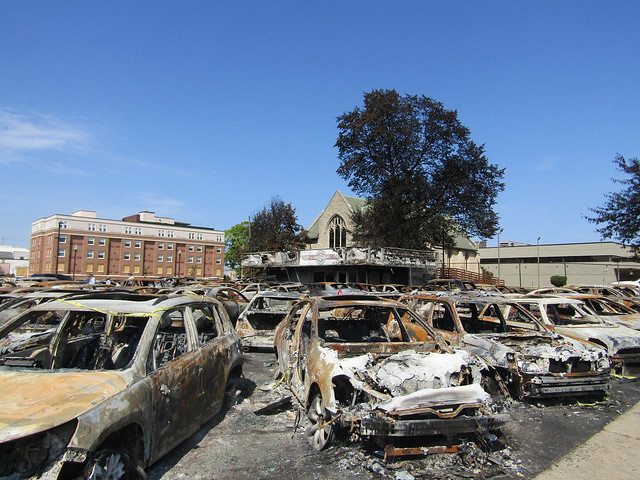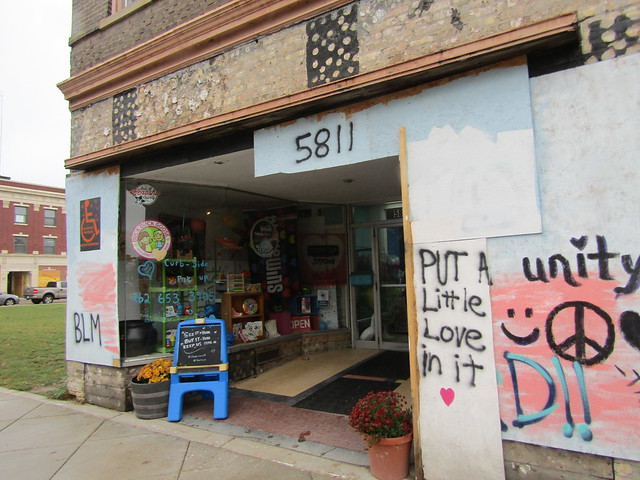Scenes from Kenosha, two months after the shooting of Jacob Blake
As I’ve commented before, we journalists have a tendency to swoop in when there’s a crisis/controversy, and then forget about it once the heat dies down. And that is something I’ve personally been trying to avoid, even when I don’t get paid for it.
Kenosha has been on my radar long before the shooting of Jacob Blake. I visited it several times - the first time back in college, in one of my “how far can the [then $5] Metra weekend pass get me” day trips. I wanted to see the only midwestern town within communing distance that had some form of tramway (a heritage-style streetcar loop that, as I quickly realized, was little more than a tourist attraction for the HarborPark development in downtown Kenosha). I visited it a few times since, because it’s the only way to go to another state on a Metra weekend pass, and while I don’t have as much inexplicable fondness for it as I do for Michigan City, it has its charms. I even visited Kenosha twice during the pandemic - once in May (when, by a strange coincidence, the Wisconsin Supreme Court struck down the state’s stay-at-home order) and once in June.
So, when the shooting happened, I already had some context. I already knew that it was a manufacturing town those existence once revolved around several major auto plants (the aforementioned HarborPark development was built on the site of large American Motors Corporation lakefront plant). I knew that the city was home to more African-Americans than many people might assume, with some living there since the days of the Underground Railroad. When protesters marched on Kenosha County Courthouse, and when riots swept through downtown and Uptown areas, I had a pretty good idea where several of those streets were.
I originally planned to try to get to Kenosha on August 24, what ended up being the second day of riots (and the day before Kyle Rittenhouse killed two protesters and wounded another), but I missed the mid-day train. Because Union Pacific North Metra Line is running on a limited schedule in these pandemic times, it meant that there was no point catching the following train, since I would basically only have time to walk around for a few minutes before I had to catch the last train back to Chicago. Paying work kept me from making another attempt until Friday, August 28. By that point, the protests continued, but they were mostly peaceful, and National Guard was brought in
As the train entered Kenosha, I saw what I later discovered were ruins of the Wisconsin Department of Corrections buildings - one of the buildings that got torched in Uptown Kenosha on August 24


When I got off the train, I saw something so unexpected that it took me a bit to figure out what I was looking at. Somebody, presumably National Guard, fenced off two blocks that contained the Kenosha County Sheriff's offices, the city police offices, the city and county jails and the Kenosha County Court building. Several civilian buildings wound up wrapped inside the perimeter.


I saw what I assume were National Guardsmen patrolling inside the perimeter


And there were cement barricades blocking off the roads on the courthouse side of the perimeter


(Later, I saw two civilians approach the perimeter near the county court and chat with guardsmen, who seemed friendly enough)

But as I looked the other way, I saw a group of girls around high school age painting murals on boarded-up windows.

The best I was able to put together, on August 25, every single downtown and Uptown business, whether they were hit or not, boarded up their windows. And on that Friday, the downtown chamber of commerce and several local churches (and possibly other organizations) coordinated a collective action to paint the murals, supplying paint, paintbrushes and food and water (bear in mind, this was August, and the weather was still quite warm). The volunteers I talked to described it as a morale booster, a way do do something positive in the face of death and destruction.
(Side note - with a handful of exception, I asked the volunteers' permission before taking any pictures that had them in the shot)

It was an interesting visit. There were a lot of murals, some with more generally optimistic messages, some with more social justice messages weaved in.

The message at one tattoo parlor was… quite a bit sharper (for those who don't get it, the acronym stands for "fuck the police"

I saw several messages urging would-be rioters to spare buildings that had apartments above the storefronts.

While passing through the Library Park (which, as the name suggests, is home to the city's main library), I came across a free stuff giveaway. I wasn't able to get a clear answer as to who organized it

Later, I came across a local activist who held the rapt curiosity of the passers-by as she talked about the painful legacy of enslavement and segregation

And, two days after the Rittenhouse shooting, I couldn't help but feel a tad nervous around bikers

And a press conference in front of the city hall I came across while heading back to the train station to catch my only train home reminded that the protests were not over (and, indeed, a peaceful protest happened later that night. I couldn't stick around to see it because, again, limited COVID-era Metra schedule)

By October, Kenosha receded from the headlines, except occasional updates on Rittenhouse and Blake cases. And, like I said, that made me curious. And, on October 23, almost exactly two months after my previous visit, I was able to stop visit again
This time, the Wisconsin Department of Corrections site was in a better shape. Maybe.

And the perimeter around the justice systems buildings was gone.

And, to be honest, I expected most of the plywood to be gone. But that's… not quite what happened. The building where I first saw the volunteers had it removed

But the same wasn't true for the building next door


And I found that some buildings that didn't have murals two months ago did now



Including one of the buildings that ended up behind the perimeter

The county courthouse is no longer behind the fence

But it still has the plywood

Before this August, I never wondered what the building across the street from the courthouse was. But when I saw it then, I was struck by how it was clearly covered by multiple layers of graffiti, with the city painting over tags and taggers painting over that.

As it turned out, this was originally the city's very first high school. What is now known as Walter Reuther Central High School went through several uses since then, and it's currently an alternative high school. Which, for those who may not be familiar with finer points of the American education system, is a school for "troubled" kids who get taken out of regular high school (and usually have an opportunity to earn their way back.

Since then, the graffiti has been cleaned up - though some windows are still boarded up

And there was even a message on the window

Across the street, a relatively simple "Save Kenosha" message

Got replaced with something more elaborate

During my August visit, one of the most striking sights I came across was the Car Source lot, which got torched during the rioting

Four days later, I could still smell the burnt gasoline

And I spotted ATF agents mulling around

Since then, the lot no longer reeks of gasoline, and some cars have been removed - but not all of them


The building across the street that used to have street art that I honestly didn't really get

now advertised a GoFundMe campaign for Car Source

One of the interesting things about the return visit was that I got to what several in-progress murals

Looked like finished

Back in August, seeing every first floor window up and down the street was startling

But in October, seeing some windows plywooded, but not others, was startling in a different way

Ditto the corner near the historic Orpheum Theater building (which, at least until the pandemic struck, served as a co-working space with a restaurant on part of the first floor). During the plywood painting collective action, the downtown chamber of commerce set up a tent with supplies and refreshments in front of it.


With some stores, you wouldn't even think they've ever been boarded up


While others haven't changed at all. To be clear, in this particular case and several others, the businesses are open - they just kept the plywood.


Some businesses kept bits of the old plywood


>
While others kept the plywood with very different murals


The second walk around drew attention to things I didn't notice. In August, I didn't think twice about the mural on the windows of Something Different collectables store

But, this time around, it was impossible not to notice that the store is closed


And the sign on the door, a bit further out of sight, is a bit more upfront about what kind of damage it was

There are plenty of businesses that are open, and, from what I've seen of other shoppers, people are more concerned about rising COVID-19 infection rates than events two months ago (As I've commented on Twitter before, as recently as August, you could tell who came off the Metra train from work and who has been hanging out in Kenosha, because virtually nobody in the city was wearing any kind of face covering. That definitely wasn't the case in October.

Yet I've wondered if some businesses haven't taken the plywood off because they liked the art

Or because they were worried about what might happen during the election

Or maybe a bit of both

Incidentally, while I've seen campaign signs for local Democrat and Republican candidates


I didn't spot a single Trump sign


One thing for certain - I will be keeping an eye on Kenosha News website as the election results come in.

And I definitely plan to visit Kenosha again - maybe in November, maybe in December, maybe even next year - and see how things have changed since then. And how long the signs of August's events will remain

Because, for Kenosha, this isn't just a city that's in the news for a few weeks. This is their home. And, whatever happens with Blake, or Rittenhouse, or anyone else, whether the outside media covers it or not, they have to live with the consequences
